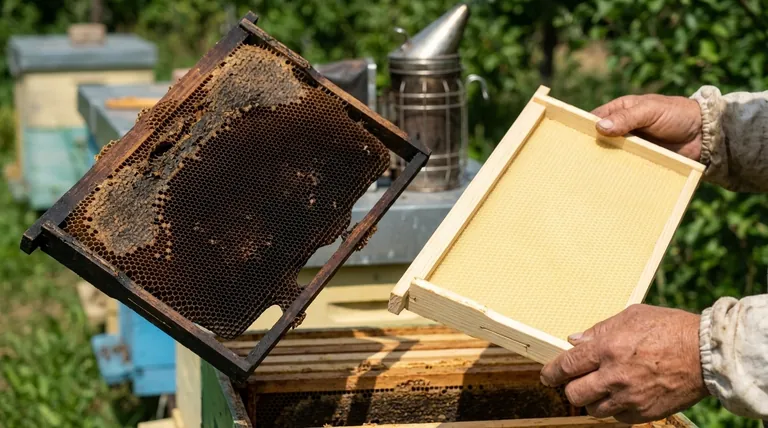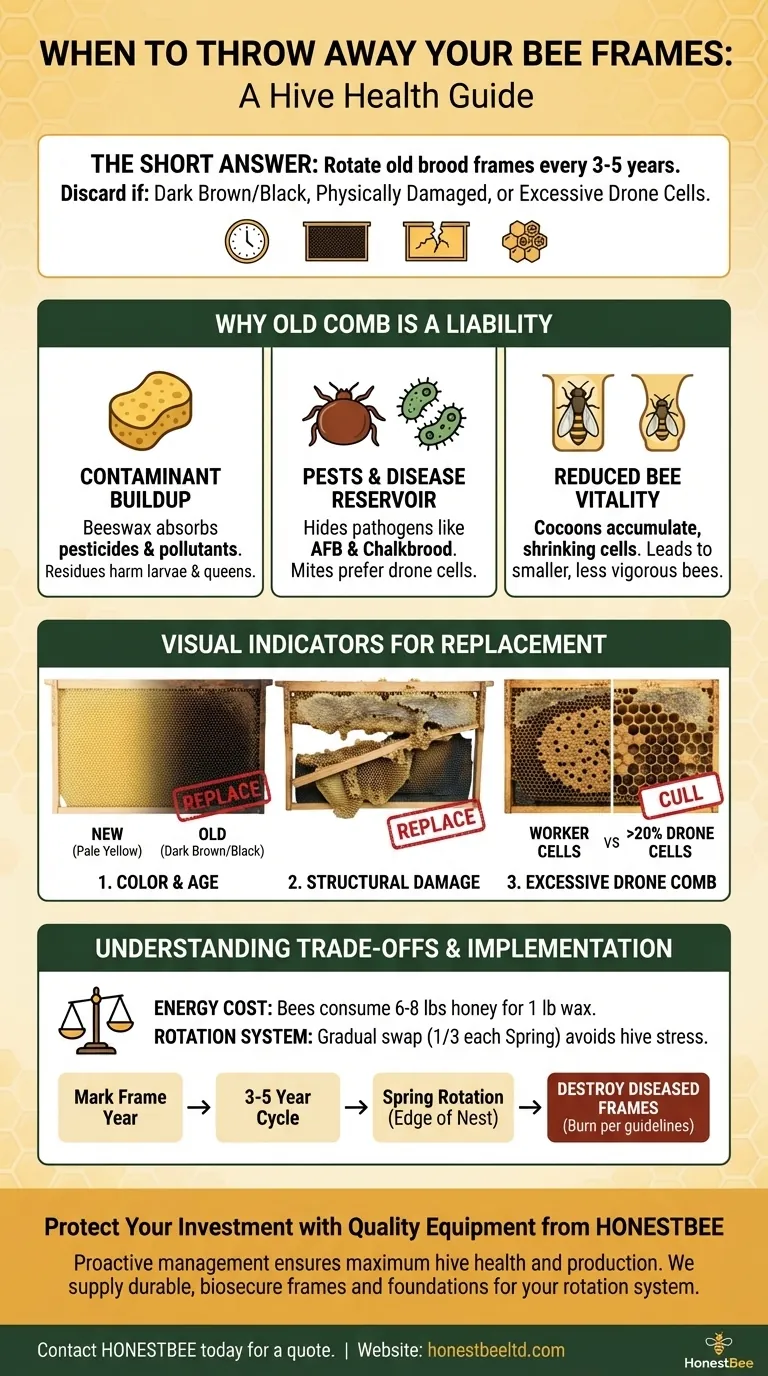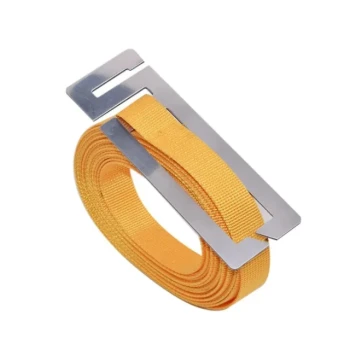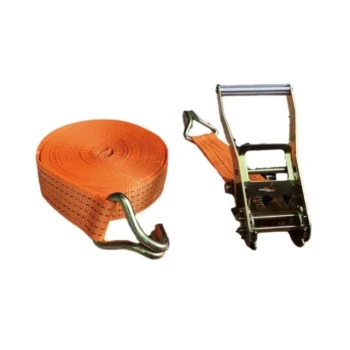The short answer is this: you should discard bee frames when the comb is dark brown or black, when the frame is physically damaged, or when it contains an excessive amount of drone cells. As a rule of thumb, it's best practice to rotate out old brood frames every 3 to 5 years to maintain a healthy hive.
The core principle is not about tidiness, but about proactive hive management. Regularly replacing old comb is a critical strategy to break disease cycles, reduce the buildup of environmental contaminants, and ensure your colony has a fresh, healthy environment for raising new generations of bees.

The Hidden Risks in Old Comb
Understanding why old comb is a liability is the key to effective hive management. Beeswax acts like a sponge, and over time, it accumulates things you don't want in your hive.
The Problem of Contaminant Buildup
Beeswax naturally absorbs fat-soluble substances from the environment. This includes agricultural pesticides, miticides used in the hive, and other environmental pollutants.
Over several years, these residues can concentrate in the wax to levels that harm larval development, reduce queen fertility, and compromise the colony's overall immune system.
A Reservoir for Pests and Disease
Old comb is a perfect place for pathogens to hide. Spores from diseases like American Foulbrood (AFB) and Chalkbrood can remain viable in old comb for years, waiting to reinfect a colony.
Additionally, Varroa mites show a preference for laying their eggs in drone cells, which often proliferate on older, stretched-out comb.
Reduced Cell Size and Bee Vitality
Each time a new bee is raised in a cell, it leaves behind a thin silken cocoon. Over dozens of cycles, these cocoons accumulate and slightly reduce the interior volume of the cell.
This gradual shrinking can lead to the hive raising slightly smaller, and potentially less vigorous, adult bees over time. Fresh comb ensures bees are raised to their full potential.
Key Indicators for Frame Replacement
While a systematic rotation plan is ideal, there are clear visual cues that tell you a specific frame needs to go.
Visual Cue: Color and Age
This is the most straightforward indicator. New comb is a bright white or pale yellow. As it's used for brood rearing, it progressively darkens.
Frames with comb that is dark brown or completely black are several years old and should be prioritized for removal. They are saturated with old cocoons and have the highest risk of contamination.
Structural Damage
Any frame that is broken, warped, or has a foundation that is sagging should be removed. Damaged frames make hive inspections difficult and can lead to unwanted cross-comb that the bees build to stabilize the structure.
This "burr comb" gets in the way of pulling frames, risks rolling and killing your queen during inspections, and disrupts the natural flow of the hive.
Excessive Drone Comb
While a healthy colony needs some drones, a frame containing more than 20% drone-sized cells is problematic. It reduces the number of worker bees the colony can raise, which impacts the hive's workforce for foraging and honey production.
More importantly, this excess drone brood is a breeding ground for Varroa mites, acting as an incubator that can dramatically increase the mite population in your hive. Culling these frames is an effective part of integrated pest management.
Understanding the Trade-offs
Replacing frames is essential, but it's a process that requires balance and an understanding of the colony's resources.
The Energy Cost to the Bees
Drawing out fresh beeswax foundation is an energy-intensive task for bees. It is estimated that bees consume 6-8 pounds of honey to produce just one pound of wax.
For this reason, you should never replace all the frames in a hive at once. A gradual rotation places a manageable burden on the colony.
The Cost of Replacement
For beekeepers managing multiple hives, the cost of new frames and foundation can be a significant factor. This reinforces the need for a sustainable rotation plan rather than a sudden, expensive overhaul.
The Risk of Over-Managing
Avoid pulling frames from the center of the brood nest during a critical nectar flow or in late fall when the bees are preparing for winter. The best time to swap frames is typically in the spring, placing new foundation at the edge of the brood nest (e.g., in position 2 or 9 in a 10-frame box) and allowing the bees to draw it out as the colony expands.
How to Implement a Frame Rotation System
A simple, consistent system is the most effective way to ensure your frames stay fresh and your bees stay healthy.
- If your primary focus is maximum hive health and biosecurity: Adopt a 3-year rotation for your brood boxes. Mark your frames with the year they were introduced and replace one-third of them each spring.
- If you are a budget-conscious hobbyist: Aim for a 5-year rotation cycle at a minimum. Prioritize removing the darkest, oldest, or most damaged frames each season.
- If you discover signs of serious disease (like AFB): Do not simply discard the frames. Follow your local agricultural guidelines, which will likely require burning the infected equipment to prevent a catastrophic spread to other hives.
Proactively managing your frames is one of the most powerful investments you can make in the long-term vitality of your bees.
Summary Table:
| Key Indicator | Why It Matters | Action Needed |
|---|---|---|
| Dark Brown/Black Comb | Saturated with contaminants, pathogens, and old cocoons. | Prioritize for immediate removal. |
| Physical Damage | Leads to cross-comb, difficult inspections, and risks to the queen. | Remove and replace the frame. |
| Excessive Drone Cells (>20%) | Reduces worker population and acts as a Varroa mite incubator. | Cull the frame as part of pest management. |
| General Age (3-5 years) | Prevents buildup of pesticides, miticides, and disease spores. | Implement a systematic rotation plan. |
Protect Your Investment with Quality Equipment from HONESTBEE
Proactive frame management is essential for commercial apiaries and distributors aiming for maximum hive health and honey production. The cost of disease or a weakened colony far outweighs the investment in fresh, reliable equipment.
HONESTBEE supplies the durable, high-quality beekeeping supplies and equipment you need to implement a successful rotation system. We help you:
- Maintain Biosecurity: Reduce the risk of American Foulbrood and other pathogens with fresh foundation.
- Boost Colony Vitality: Ensure your bees are raised to their full potential in clean, correctly sized cells.
- Manage Costs Effectively: Our wholesale-focused operations provide the equipment you need at a sustainable cost for your business.
Ready to build a healthier, more productive apiary? Let's discuss your equipment needs.
Contact HONESTBEE today for a quote on frames, foundations, and other essential supplies.
Visual Guide

Related Products
- Wooden Bee Hive Frames for Beekeeping and Wholesale
- Copper Bee Frame Eyelets for Beekeeping
- Professional Galvanized Hive Strap with Secure Locking Buckle for Beekeeping
- HONESTBEE Professional Long Handled Hive Tool with Precision Cutting Blade
- Langstroth Honey Bee Box Hive Boxes for Different Depths
People Also Ask
- What color options are available for plastic frames, and what is the benefit of black frames? Boost Your Hive Inspection Efficiency
- What is the recommended number of frames for a beginner beekeeper? The Essential Rule for a Healthy Hive
- What are the standard sizes of frames used in Langstroth hives? Choose the Right Frame for Your Apiary
- Will honey bees clean up old frames? A Guide to Safe and Efficient Frame Reuse
- What is the role of oxalic acid in plants? A Key to Plant Defense and Internal Regulation



















